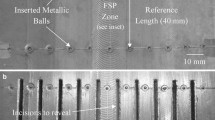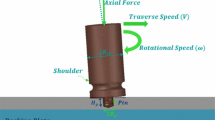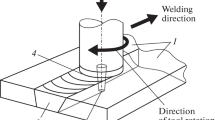Abstract
The three-dimensional model for friction stir welding was established by coupling thermal, force, and flowing fields. The weld shape, surface stripes, weld defect, temperature field, and material flow behavior were predicted. The transient heat transfer phenomenon and material mixing pattern at the stir zone was primarily studied. The material flow mechanism was investigated. The experimental results strongly supported the reliability and accuracy of the model and simulation. The rotational speed to welding speed ratio \( {R}_{\omega /{U}_w} \) plays an important role in transient heat transfer, temperature field, velocity field, material mixing pattern, and weld defect appearance.
Similar content being viewed by others
References
Nandan R, DebRoy T, Bhadeshia HKDH (2008) Recent advances in friction-stir welding—process, weldment structure and properties. Prog Mater Sci 53:980–1023
Cam G (2011) Friction stir welded structural materials: beyond Al-alloys. Int Mater Rev 56:1–48
Çam G, Mistikoglu S (2014) Recent developments in friction stir welding of Al-alloys. J Mater Eng Perform 23:1936–1953
Schmidt H, Hattel J (2005) A local model for the thermo-mechanical conditions in friction stir welding. Model Simul Mater Sci Eng 13:77–93
Sonne MR, Tutum CC, Hattel JH, Simar A, de Meester B (2013) The effect of hardening laws and thermal softening on modeling residual stresses in FSW of aluminum alloy 2024-T3. J Mater Process Technol 213:477–486
Carlone P, Palazzo GS (2013) Influence of process parameters on microstructure and mechanical properties in AA2024-T3 friction stir welding. Metall Microstruct Anal 2:213–222
Smith CB, Bendzsak GB, North TH, Hinrichs JF, Noruk JS, Heideman RJ (2000) Heat and material flow modeling of the friction stir welding process. Proc Ninth Int Conf Computer Technol Weld., Detroit, MI, USA
Ulysse P (2002) Three-dimensional modeling of the friction stir welding process. Int J Mach Tools Manuf 42:1549–1557
Deng XM, Xu SW (2004) Two-dimensional finite element simulation of material flow in the friction stir welding process. Int J Mach Tools Manuf 6:125–133
Colegrove PA, Shercliff HR (2005) Three-dimensional CFD modelling of flow round a threaded friction stir welding tool profile. J Mater Proc Technol 169:320–327
Heurtier P, Jones MJ, Desrayaud C, Driver JH, Montheillet F, Allehaux D (2006) Mechanical and thermal modelling of friction stir welding. J Mater Proc Technol 171:348–357
Zhang HW, Zhang Z, Chen JT (2007) 3D modeling of material flow in friction stir welding under different process parameters. J Mater Proc Technol 183:62–70
Nandan R, Roy GG, Lienert TJ, Debroy T (2007) Three-dimensional heat and material flow during friction stir welding of mild steel. Acta Mater 55:883–895
Jacquin D, De Meester B, Simar A, Deloison D, Montheillet F, Desrayaud C (2011) A simple Eulerian thermomechanical modeling of friction stir welding. J Mater Proc Technol 211:57–65
Zhang ZH, Li WY, Li JL et al (2014) Effective predictions of ultimate tensile strength, peak temperature and grain size of friction stir welded AA2024 alloy joints. Int J Adv Manuf Technol 73:1213–1218
Zhang Z, Zhang HW (2014) Solid mechanics-based Eulerian model of friction stir welding. Int J Adv Manuf Technol 72:1647–1653
Al-Badour F, Merah N, Shuaib A et al (2014) Thermo-mechanical finite element model of friction stir welding of dissimilar alloys. Int J Adv Manuf Technol 72:607–617
Buffa G, Hua J, Shivpuri R, Fratini L (2006) A continuum based fem model for friction stir welding-model development. Mater Sci Eng A 419:389–396
Zhang XX, Xiao BL, Ma ZY (2011) A transient thermal model for friction stir weld. Metall Mater Trans A 42:3218–3228
Song M, Kovacevic R (2003) Thermal modeling of friction stir welding in a moving coordinate system and its validation. Int J Mach Tools Manuf 43:605–615
Lin BY, Yuan P, Liu JJ (2011) Temperature distribution of aluminum alloys under friction stir welding. Adv Mater Res 264–265:217–222
Wang L, Xie LY (2011) Measurement and analysis of temperature in friction stirring welding process. Light Alloy Fabr Technol 39:54–59
Rajakumar S, Muralidharan C, Balasubramanian V (2010) Influence of friction stir welding process and tool parameters on strength properties of AA7075-T6 aluminium alloy joints. Mater Des 32:535–549
Rajakumar S, Muralidharan C, Balasubramanian V (2010) Establishing empirical relationships to predict grain size and tensile strength of friction stir welded AA 6061-T6 aluminium alloy joints. Trans Nonferrous Metals Soc China 20:1863–1872
Rajakumar S, Muralidharan C, Balasubramanian V (2011) Predicting tensile strength, hardness and corrosion rate of friction stir welded AA6061-T6 aluminium alloy joints. Mater Des 32:2878–2890
Rajakumar S, Balasubramanian V (2012) Correlation between weld nugget grain size, weld nugget hardness and tensile strength of friction stir welded commercial grade aluminium alloy joints. Mater Des 34:242–251
Morisada Y, Fujii H, Kawahito Y, Nakata K, Tanaka M (2011) Three-dimensional visualization of material flow during friction stir welding by two pairs of X-ray transmission systems. Scripta Mater 65:1085–1088
Zhang HW, Zhang Z, Chen JT (2005) Effect of angular velocity of the pin on material flow during friction stir welding. Acta Metall Sin 41:853–859
Author information
Authors and Affiliations
Corresponding author
Rights and permissions
About this article
Cite this article
Luo, J., Li, S., Chen, W. et al. Simulation of aluminum alloy flowing in friction stir welding with a multiphysics field model. Int J Adv Manuf Technol 81, 349–360 (2015). https://doi.org/10.1007/s00170-015-7228-6
Received:
Accepted:
Published:
Issue Date:
DOI: https://doi.org/10.1007/s00170-015-7228-6




